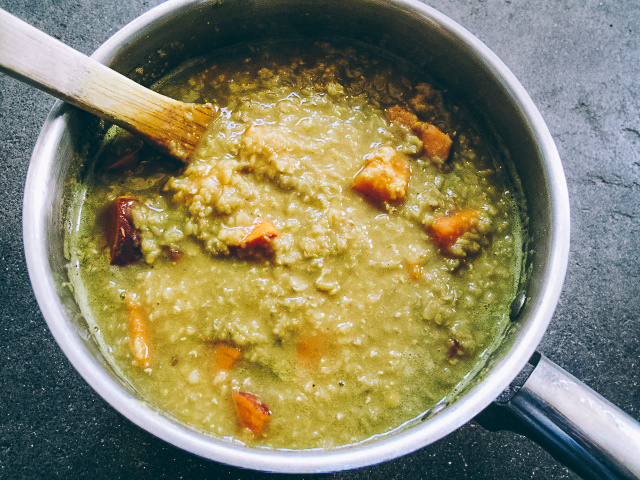
One of my goals for this space this year is to share a nutrition tip each month which can guide us towards preparing and enjoying better meals. I’ve been sitting on this first topic for the better part of the last year, and it’s one that has been increasingly on my mind.
Let’s talk about cooking with different types of fats and oils.
For quite some time, I’ve tended to use olive or coconut oil for a lot of recipes. Up until a few years ago, I almost exclusively used extra virgin olive oil for all purposes outside baking sweets, at all temperatures. While I was familiar with the term “smoke point,” I never thought much of it, because I never saw smoke. What I didn’t realize was that I was wrong.
While there are many different kinds of fats and oils, some are more delicate than others, meaning their beneficial compounds break down or oxidize easily, creating harmful chemicals in the process. Those chemicals damage cells, promote widespread internal (and invisible) inflammation, and lead to a vast number of health concerns now considered common such as cardiovascular disease and cancer.
The three factors that cause fats and oils to oxidize and create harmful chemicals include exposure to heat, light, and oxygen, and the more unsaturated a fat is, and thus a lower smoke point, the more easily one of these factors will cause it to become highly inflammatory to our system.
My longtime go-to, extra virgin olive oil, is similar to most vegetable/plant oils, and is not particularly stable at temperatures above 320 degrees F (its smoke point). This means it is not suitable for stir-frying, sautéing, baking or roasting, or other high-heat cooking methods. What’s more, unsaturated oils such as corn, soybean, sunflower, and others which we’ve heard can stand up to high heat have instead been found to break down extremely easily at high temperature. In research, these were found to be some of the worst types of oil to cook with.

So the question remains: what type of fat or oil can you use (safely) for high temperature cooking, such as roasting, baking, sautéing, and stir-frying?
Essentially, I no longer recommend cooking much above 350 degrees using any type of fat or oil unless it’s a special occasion. But when those high-heat-necessary meals are prepared, using fats that are more stable (and thus more saturated), hold up the best. This means coconut oil, butter and ghee (if you’re not sensitive to or actively avoiding dairy) are best. The other option is to choose a lesser quality (non virgin) olive, sesame oil, and possibly small amounts of non-gmo canola oil for baking. These oils are rich in monounsaturated fats, which tend to be slightly more stable at temperatures up to 350 degrees. And because they’re less refined and ideally cold-pressed, that fatty acid oxidation won’t be happening as much during the processing/pressing, since we’re aiming to avoid oxidized and rancid oils, especially before they even makes it home to cook with!
This also leaves the really-good-for-you extra virgin olive oil, as well as omega-3 rich flax and walnut, for drizzling on dishes after they’re off the heat. And if you really want to get right down to it, using less oil of all types and more fat-rich whole foods (like nuts, seeds, olives, and avocados) can never be a bad way to go.

Quick Sautéed Greens, serves 1-2
Early in the new year might be the time when some of us are actively adding more greens to our routines, but a cold kale or green salad is often not the best when it’s cold outside and we’re bundled in layers. This is my favorite way to eat greens in the winter. The cooking process takes but a minute and the result is garlic-y, lightly spiced, and delectable. They’re a great addition to almost any meal.
1 tsp. unrefined coconut oil
1 large clove garlic, smashed and minced
1 bunch winter greens (Collards, Kale, Swiss chard, etc.), stems chopped, leaves sliced
1 tsp. grounding masala, optional
salt and pepper to taste
- In a medium sauté pan, heat the oil over medium-high. Add stems from the greens and allow to cook until beginning to soften.
- Then add in the garlic, sliced leaves, and masala and heat just until the leaves begin to wilt. Remove from heat and add salt and pepper to taste.
RESOURCES:
Malhotra, A. (2016). The toxic truth about vegetable oil: Cooking with ‘healthy’ fats increases the risk of disease, type 2 diabetes and cancer. Retrieved from http://www.dailymail.co.uk/health/article-3574810/The-toxic-truth-vegetable-oil-Cooking-healthy-fats-increases-risk-heart-disease-type-2-diabetes-cancer.html?utm_sq=fjjqojxgyn.
Peng, C.Y., Lan, C.H., Lin, P.C., and Kuo, Y.C. (2017). Effects of cooking method, cooking oil, and food type on aldehyde emissions in cooking oil fumes. Journal of Hazardous Materials, 324(Pt B), 160-167. doi: 10.1016/j.jhazmat.2016.10.045.
Pitchford, P. (2002). Healing with Whole Foods: Asian Traditions and Modern Nutrition (3rd ed.). Berkeley, CA: North Atlantic Books.
Uribarri, J., Woodruff, S., Goodman, S., Cai, W., Chen, X.,…and Vlassara, H. (2010). Advanced glycation end products in food and a practical guide to their reduction in the diet. Journal of the American Dietetic Association, 110(6), 911-16.e12. doi: 10.1016/j.jada.2010.03.018.

























































